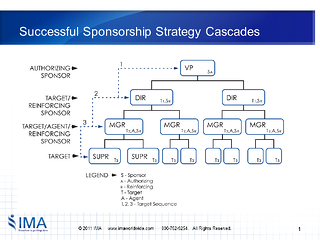We say that “Sponsorship” is the most critical success factor in ensuring a fast and successful implementation of any type of business change. But as a Change Agent, do you know who your Sponsors actually are, and maybe more importantly, what they are doing to ensure the success of your change project? These are critically important questions, but their answers may not necessarily be all that obvious. 
The fact is there are often far more Sponsors who need to be attended to than what Change Agents originally think. Too often, Change Agents spend the bulk of their energy and time focused on trying to create what we call "enthusiastic Targets" without understanding that there are many leaders who have far more impact on the success of the project! No Target is more important than these Sponsors who must provide demonstrated commitment through their own behavior {Tweet This}.
What is Sponsorship?
In the Accelerating Implementation Methodology (AIM), change management methodology developer Don Harrison defines 4 crucial implementation roles as the change CAST of Characters. Sponsors are defined as those who authorize, legitimize and demonstrate ownership for the change. There are two types of Sponsors:
- The Authorizing Sponsor legitimizes the change and provides the required resources in his/her line of authority.
- The Reinforcing Sponsor demonstrates commitment through his/her personal action with those direct reports who are impacted by the change.
Sponsorship is not a voluntary position. Leaders can’t simply raise their hand and say, “That’s a great idea, I’ll Sponsor that project!” Management team members are automatically put in this role if they have people reporting to them who are impacted by the change.
Identifying Every Sponsor is a Key Change Management Deliverable
So, how do you identify Sponsors? In our change management training and consulting, we teach and follow a rigorous process and produce a deliverable called a Key Role Map. The Key Role Map provides a graphic  depiction of all your Sponsors based on identifying all the Target groups that are impacted by your change.
depiction of all your Sponsors based on identifying all the Target groups that are impacted by your change.
If you think you know who all those Target groups are already, we can almost guarantee that you are missing some groups unless you have completed a Key Role Map! "Those impacted" include any resources you have working on the project, and all the support services that are involved in some way in your change. So, for example, if the IT organization and/or the Training organization are providing support services, they need to be included in your Key Role Map. Remember, each and every resource must be Sponsored!
Sponsors’ Actions
Once you have identified where all of your Sponsors are, each one must be aware of what is required for implementation success. There are three very specific actions each and every Sponsor must demonstrate visibly with their direct reports on a daily basis:
- Express- commitment to the change
- Model- commitment to the new behaviors through actions like resource allocation, decision-making, etc.
- Reinforce- the new behaviors (the behaviors “we seek to see”) through application of rewards and consequences
It is the cascade of Sponsors at each management level—each of whom is Expressing, Modeling and Reinforcing his or her personal commitment to the initiative, that enables you to move your implementation at speed. All Sponsors in this cascade must be consistent in what they say, do, and reinforce.
Maintaining Sponsorship
Here are a few tips on how to help maintain committed, active Sponsorship throughout the lifecycle of your project:
- Educate your Sponsors on what behaviors are expected of them. Many Sponsors are simply not aware of what it takes to be a good Sponsor!
- Contract with Sponsors for what you need from them right now. Sponsor Contracting is the framework of the discussions you have where you ask for what you need with precision and clarity.
- Make sure that all Sponsors are working toward the same future state. Compare your Authorizing Sponsor's definition of the change, and its outcome, with what you are seeing on the ground operationalized by each of the Reinforcing Sponsors.
- Use the Sponsor Assessment Tool as a way of monitoring what your Sponsors are doing to Express, Model, and Reinforce their commitment to the change with their direct reports.
Securing and maintaining project Sponsorship may be complicated and it is certainly labor-intensive, but it is arguably the most important activity of any Change Agent. When Change Agents miss the mark in identifying all of their project Sponsors, or don’t know what their Sponsors are “out there” doing, value realization is at risk.


